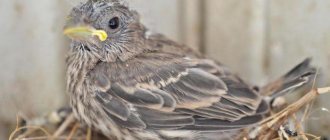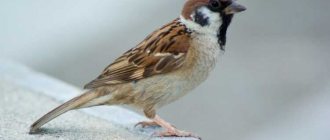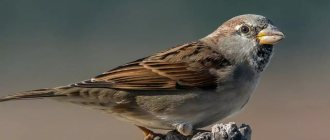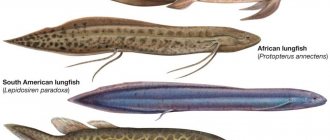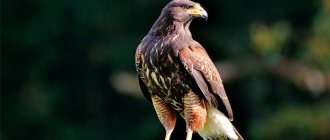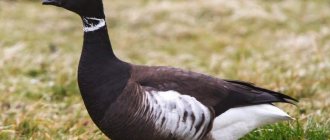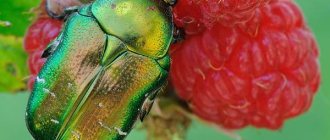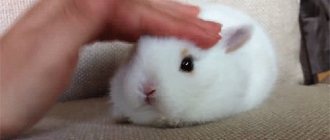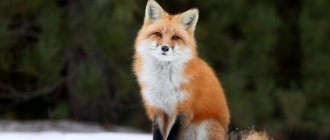Sparrow bird. Sparrow lifestyle and habitat
In our regions, the sparrow is considered one of the most common birds. People are so accustomed to these birds that sometimes they don’t even notice their presence. Sparrows are everywhere - on the roofs of houses, on wires and simply hovering in the air.
They belong to the passerine family. It is only at first glance that it may seem that the sparrow bird is stupid and inconspicuous in anything. In fact, this is quite an interesting and gifted bird. From observations, these permanent neighbors of people have excellent memory, obstinate, cocky and sociable disposition.
With the appearance of these smart, daring and courageous birds, we associate the approach of spring. They are one of the very first birds to hurry to tell us with their sonorous chirping, jumping across newly thawed puddles, that winter is finally over.
In fact, the sparrow’s voice is so clear and joyful that not only the arrival of spring, but also the arrival of spring makes you feel incredibly joyful and good in your soul. The loud chirping of a sparrow is an enthusiasm that is transmitted to everything around.
Outdoor games for kids about sparrows and other birds.
Pigeons, sparrows and a crow.
Children are pigeons and sparrows. The leader is a crow. Children depict the habits of their birds - how they walk, how they peck grains. Pigeons walk slowly and importantly, sparrows jump quickly.
The crow flies out! The birds must run beyond the outlined line from the crow. Those who didn’t make it in time, and whoever was hit by the crow, become the leader in the next game.
Sparrows and a car.
Game for children 3-4 years old. The sparrows jump and peck the grains. When a car appears (a child holding the steering wheel in his hands, who blows: “Beep-beep-beep”), the sparrows scatter in all directions from the car
Sparrows and crows.
A very fun game for children, which is often played at folk festivals or on family trips. Draw two lines on the ground or floor. The lines should be located three steps apart and should be parallel. Stepping back from these lines another 20-30 steps, draw two more parallel lines.
All players are divided into two teams. One team of crows, the other team of sparrows. They stand with their backs to each other on two lines in the middle of the playing field.
The presenter loudly pronounces the command: “Voro - pause - beat!” or “Voro - pause - us!” The team named by the leader runs to the far line. Players from the other team try to catch up with them and tarnish them.
The winning team is the one that has damaged more players from the second team during the game. The game is repeated six to eight times.
Description and features
Their incomparable appearance and chirping help to recognize these amazing birds. Initially, their plumage may appear to be gray. Looking closely, you can see brown shades with black splashes on top of the feathered bird. The head, area near the ears, and abdomen of the bird are painted light gray.
The bird has a fairly powerful beak and a short tail. Birds of small size. The average length of their body reaches up to 15 cm. And sparrows weigh no more than 35 g. The wingspan reaches up to 26 cm.
There are noticeable differences between males and females. The very first of them is that males are always larger than females. The male has a clearly visible black spot. It is located in front on the chin and breasts.
The head of the bird is much darker than that of the female. She also lacks a black spot. Her chest and top of her head are painted light gray. And the eyes are decorated with a barely noticeable gray-yellow outline. The birds stand on short limbs with weak claws. Their wings are short.
The most basic feature of sparrows is that they are in close contact with people everywhere. You can meet them both in populous cities and in modest, almost deserted villages and fields. On ships, these travelers find themselves in places where they have never been before and remain there for permanent residence.
In essence, this is a sedentary bird that almost never leaves its familiar territory. Sparrows can rarely cross the line of this area, and then only in order to scout out what is happening beyond it.
Currently, large flocks of sparrows are observed, which live, despite their massive concentrations, in excellent proximity to people, birds and animals.
But sparrows do not establish trusting and peaceful relationships with all birds. These robbers can sometimes completely drive tits and swifts out of areas. Small birds sometimes cannot withstand the strong pressure of the impudent little ones and give up their territory to them.
Sparrows have excellent memory. They can connect everything connected with a person into a logical chain. They are afraid of cats, but they can, at their own peril and risk, tease her at her own feeding trough. The same picture can be observed in relation to horses.
Sparrows are not at all afraid of rabbits and chickens. They freely sneak into their territory and share a meal with them. Sparrows are not afraid of people. But they are precisely those birds that are very difficult to tame, so a photo of a sparrow and a person is a real rarity. True, there are isolated cases of people becoming friends with these birds, but this really happens very rarely.
Riddles about the sparrow
1. This little bird wears a gray shirt, quickly picks up crumbs and escapes from the cat.
2. I catch bugs all day and eat worms. I don’t fly to warm regions. I live here, under the roof. Tick-tweet! Don't be timid! I'm experienced... (sparrow)
3. Mischievous Ivashka Gray shirt. Jumps along the paths Toward the seeds and crumbs. In the cold and in the heat Jumps around the yard. Not afraid of the cold. Swimming in a puddle.
4. This gray bird nests in people’s yards. Gray feather outfit. The beady eyes sparkle. Jump and hop and “chik-chirk” Fussy and small. Crumbs rash and don’t be sorry! Who will peck them?
Character and lifestyle of a sparrow
These sedentary birds prefer to nest in one place. Their offspring remain with their parents after growing up, so these birds form very large flocks. A pair of birds find one for life.
For their nests, sparrows choose a variety of places where they can be placed. The nest of this bird can be seen on the eaves of a balcony, birdhouse, in empty wooden and brick buildings, among pipes and even heaps of garbage.
The character of these birds is distinguished by its nastiness. They fiercely and jealously guard their possessions. They boldly fight for their territory and survive birds that are even larger in size. In addition, they show their temper not only towards strangers. They can bully their relatives with or without reason.
Silence and silence are absolutely not characteristic of these birds. The slightest movement near them causes a very violent reaction, which is accompanied by noisy sounds.
In spring, when pairs form between birds, it becomes especially noisy and “hot”. Males fight for primacy among themselves not only on trees and rooftops, but also high in the sky.
There are no bloody consequences after this. The rivals scatter in different directions, but some time passes and they fight again.
Calls, nursery rhymes and teases about the sparrow
Introduce the kids to the folk chants that are chanted when they see sparrows on the street. Say rhythmically:
Sparrow, sparrow! Don't chase the pigeons! Don't bite the sand, Don't dull your sock! A sock on a spike of oats will come in handy.
Not all children understand what the words “don’t tip your toe” mean in this chant. Therefore, ask the kids why it is impossible for a sparrow to “stub his nose - sock” and explain that here the sparrow’s beak is called this word. And his beak will also be useful for pecking oat grains.
Sparrows were teased like this:
Tweet-chir-sparrow! Peck, peck hemp! Crack - food, bring hemp!
Chio, chio, whew-whew-whew! Chiki-chirik! Whose-whose-whose! Chin chin more! Chin chin more!
Another nursery rhyme about a sparrow for the little ones, the reading of which is accompanied by the movements of the baby’s hands.
Habitat
There are about 35 species of sparrows in nature. Each of them has its own external distinctive features and habitat. You can meet these birds everywhere, except for cold continents, where life is practically absent.
Birds are not picky about anything. They follow a person wherever they go. They easily found refuge in Australia and developed the territory of the tundra and forest-tundra. Places where, to put it mildly, life does not seem like a fairy tale to everyone. There are very few places left that are not inhabited by these birds.
Relation to Masha
After the crow pecked hard and threw Pashka out of the stall, he felt very bad: his head was very white, he was hungry and it was cold to lie in the snow.
The sparrow was saved by a policeman. He warmed Pashka in a mitten and invited the girl Masha to take him in as an upbringer. Masha took the sparrow home, smoothed its feathers with a brush and fed it. Pashka quickly recovered and began to think about how to thank Masha. First, he brought her a frozen horned caterpillar, and then began to return to her the things that the crow had stolen from the Machine's room.
Types of sparrows
It has already been mentioned that in nature there are about 30 species of sparrows. Each of them is characterized by a certain characteristic and habitat area. Some of them are worth considering.
The House Sparrow is the most common one. The length of its body does not exceed 16 cm. Its entire back is decorated with rust-colored plumage with black splashes. Gray colors are visible on the abdomen, the cheeks of the bird are painted white.
House Sparrow
The wings of the bird are yellow with white stripes, and black feathers are visible on the neck. Courage, cunning and importunity are inherent in these birds. You can meet them in the open spaces from Siberia to Portugal.
For a long time they have been found in Australia and on the American continent. House sparrows can damage agriculture, fruit trees and vineyards. But they also provide great benefits in the form of the destruction of harmful insects.
tree sparrow
The tree sparrow is smaller than the house sparrow. It has a red-gray nape and parietal area, black cheeks and several stripes across its wings. They prefer to live not in populated areas, but in the fields. In winter they can move closer to human habitation. Europe and Central Asia are habitats of tree sparrows.
The rock sparrow prefers rocky terrain in southern Europe. They are gray-brown in color with a yellow stripe near the eyes and a yellow spot in the throat area.
Stone sparrow
They take a large part in the destruction of insect pests. Stone sparrows are most often found near us. They are the ones who warn us about the coming of spring.
The snow sparrow lives in the South-East of Altai and the Caucasus. It is a very beautiful bird with black and white wings and a tail edged with white and a black patch on the throat. The snow sparrow makes sounds that cannot be compared with anything else.
Snow sparrow
The camel sparrow bird is not actually a sparrow at all. This name was given to the ostrich, which, apart from the name consonant with the sparrow, has nothing in common.
Stories about a sparrow for children.
Without words (N. Sladkov)
- Why are they, fools, afraid of me? - asked Lucy. -Who is afraid of you? - I asked. - Sparrows. Sparrows were jumping in the park. Lucy threw crumbs at them, and they flew away in fear. - Why are they flying away? - Lucy was surprised. The girl asked me a riddle! Indeed - why? I didn’t think about it before: they are afraid and afraid. That's why they are wild birds. But the girl wants to feed them, the sparrows are hungry, but they fly away. Why? - Why are they afraid of me? I never offended them! - says Lucy. “It’s not your fault,” I reassure her. - Who is to blame? - We are to blame. That's all. Some - because they always offended the birds, others - because they allowed them to be offended. - But why offend them? They’re small... “Nothing,” I said to Lucy. - You throw and throw crumbs at them, and they will understand that you are their friend. - Do you think they will understand? - They will certainly understand! After all, they understood that they had to save themselves when stones were thrown at them. “I’ll tell them that I don’t throw stones, but crumbs!” “You don’t need to say anything, Lucy.” They will understand without words. - Without words? And I thought they were fools! - said Lucy. The birds understood Lucy.
Sparrow (Evgeny Charushin)
Nikita and dad went for a walk. He was walking and walking and suddenly he heard someone chirping: “Chilik-chilik!” Chilik-chilik! Chilik-chilik! And Nikita sees that it is a little sparrow jumping along the road. So ruffled, just like a ball rolling. Its tail is short, its beak is yellow, and it doesn’t fly anywhere. Apparently he doesn’t know how yet. “Look, dad,” Nikita shouted, “the sparrow is not real!” And dad says: “No, this is a real sparrow, but only a small one.” This is probably the chick falling out of its nest. Then Nikita ran to catch a sparrow and caught it. And this little sparrow began to live in a cage at our house, and Nikita fed him flies, worms and a bun with milk. Here is a sparrow living with Nikita. He screams all the time and asks for food. What a glutton! As soon as the sun appears in the morning, he will chirp and wake everyone up. Then Nikita said: “I will teach him to fly and release him.” He took the sparrow out of the cage, sat it on the floor and began to teach. “You flap your wings like this,” Nikita said and showed with his hands how to fly. And the sparrow jumped under the chest of drawers. We fed the sparrow for another day. Again Nikita put him on the floor to teach him to fly. Nikita waved his arms, and the sparrow flapped its wings. The sparrow has flown! So he flew over the pencil. A red fire truck flew over. And when he began to fly over the inanimate toy cat, he bumped into it and fell. “You’re still a bad flyer,” Nikita tells him. - Let me feed you for another day. He fed and fed, and the next day the sparrow flew over Nikitin’s bench. Flew over a chair. Flew over the table with the jug. But he couldn’t fly over the chest of drawers - he fell. Apparently, we still need to feed him. The next day Nikita took the sparrow with him into the garden and released it there. The sparrow flew over the brick. Flew over a stump. And he began to fly over the fence, but bumped into it and fell. And the next day he flew over the fence. And flew over the tree. And flew over the house. And he completely flew away from Nikita. That's how great it was to learn to fly!
Nutrition
Sparrows eat everything in the literal sense of the word. They don't have any special preferences. They eat insects, grain, crumbs, human food waste. These birds are not particularly modest. They can sit and brazenly look into the mouth of a person who is eating at a table in an outdoor cafe.
If you remain motionless in this case for some time, the bird can safely climb onto the table and grab what attracted its attention. The slightest movement causes the bird to flee. Birds do not have greed for food. The whole flock flocks to the tasty morsel, after which the feast begins.
Unfamiliar food is tried with great caution. Summer time is especially good for country sparrows. In the village they simply have a huge abundance of food. Moreover, the scarecrows built by people in the garden to scare away birds are absolutely not scary for sparrows.
In addition to this food, sparrows also feed on caterpillars and other harmful insects, which in large quantities can cause irreparable harm to the national economy.
Where does the word "sparrow" come from?
The first secret of sparrows is why they are called that? Ask your child to guess where the name of the sparrow came from: “Beat the thief!” Hit the thief!” Oh, that’s how it turns out, “beat the thief.” So the sparrow is our thief! What is he stealing? Probably grains. And what else? Crumbs. Whose sparrow steals grains and crumbs? In pigeons, dogs, cats and even in people (Of course, you have seen with children how nimble sparrows carry crumbs right from under the noses of clumsy, slow pigeons. And at a bird feeder, sparrows will not get confused and will not be left without food! And because... under the dog's nose they can grab the crumbs right from its bowl). It turns out that while others are gaping, the sparrow is right there - stealing the grain. And in this “beat the thief” the character of the bird sounds - nimble, agile, cunning, pugnacious, brave. cocky.
But scientists think differently. They believe that our sparrow is not our thief at all. They say that the word "sparrow" comes from the ancient "thief". From this “thief” the words we know as “fence” or “gate” come from. Why then “throw and beat”? Because a sparrow is a bird that sits on fences and gates and has lived next to a person for a long time.
There is another opinion. That the word “sparrow” is based on the word “vork” - coo, grumble. And sparrows got their name because they are restless and tweet all the time,
Reproduction and lifespan
At the end of winter, the songs of sparrows are heard and some of their fuss is noticeable. This indicates that their mating season is approaching. Fights between rivals can very rarely be avoided. As a result, a couple is formed for life, which by the end of March is building its own family nest.
In April, the female lays eggs. There are usually no more than 8 of them in a nest. The male and female will need about two weeks to hatch them. And they do this together.
Parents also feed insects and take care of their newborn babies together. From such care, the chicks quickly become winged. This happens in early June. At this time, parents begin to make a second clutch. If living conditions are appropriate, they may have about three such clutches.
They do not live long, about 5 years. But among the sparrows there were also long-livers who lived twice as long. The short lifespan of these birds occurs due to the severity of winters in some places.
Source
Sparrows in the spring: how the chicks appear.
Are sparrows happy about winter? What about spring? Why? (they are not happy in winter, because in winter it is very difficult for them to feed themselves. But in spring they are happy, chirping, swimming in puddles) Listen to what they sing about when winter ends.
What do the sparrows sing about on the last day of winter? -We survived! -We made it! We are alive! -We're alive! V. Berestov
In spring, sparrows build nests under eaves, in attics, in cracks, and in abandoned hollows. They insulate them with rags, hairs, and feathers. The sparrows' nests are not very beautiful, they were hastily made. After all, they are special birds. They manage to hatch and raise chicks two or three times during the warm season! And all the other birds only manage to hatch their chicks once!
Adult sparrows eat seeds, millet, and crumbs. And the chicks that hatch in the spring are fed insects. When the chick grows up, it also begins to eat seeds and grains.
Sparrows have many enemies. And you will meet the most important enemy of sparrows and their chicks in the cartoon “High Hill”. And you will also find out what can happen to a sparrow who does not want to be friends with other sparrows. After all, with birds, like with real friends, “One for all and all for one!”
A sparrow is a bird that is very popular in Russian folk games and amusements and in modern fairy tales and cartoons. Many interesting round dance games, poems, and songs have been invented about her, which I want to introduce you to now.
Sparrows: description
Nature is so diverse and numerous in bird species that in the natural environment there are quite a few species of birds that are similar to sparrows. However, not all of them belong to the passerine family or to the sparrow species. Scientists have identified 22 species of these birds, and 8 of them are most widespread and live around us.
These types include:
Appearance
The sparrow is a bird familiar to everyone, both adults and children. This is a small bird, which, at first glance, has a monotonous gray-brown plumage color, but if you look closely, you can find more contrasting tones, more dark or even black. The head, abdomen and ear areas are painted in light shades, and their intensity varies from light gray to light brown tones.
The sparrow has a powerful beak of a dark shade, and the tail is short and colored in the same tones. Sparrows grow up to a maximum of 15 centimeters, weighing no more than 35 grams. The wingspan of the bird reaches about 27 centimeters.
Interesting moment! The sexual dimorphism of these birds is quite pronounced. Firstly, males are noticeably larger than females, and secondly, females lack a bright spot in the front of the chin and on the chest.
The eyes of these birds have a barely noticeable border of gray-brown color. Sparrows have short, thin legs armed with weak claws. People mostly see house sparrows or tree sparrows every day.
These two species differ in the coloration of the males' heads. The male house sparrow has a peculiar gray cap on the crown of his head, while the male tree sparrow has a chocolate-colored cap. House sparrows have one light stripe on each wing, while the tree sparrow has two. The tree sparrow has black brackets on its cheeks, and a light stripe in the form of a “collar” runs around its neck. The house sparrow's body shape is rougher, with the house sparrow being much larger than the tree sparrow.
Types of sparrows with photos
Almost all types of sparrows have their own characteristic differences compared to their relatives, for example:
Black-breasted sparrow (Passer hispaniolensis)
The black-breasted sparrow has a chestnut coloration on the head, neck, nape and wings. In the area of the back, bright light specks catch the eye, and the sides of the bird and cheeks are lighter in color. The throat area, crop, upper chest, as well as the strip separating the ears are black. A narrow, dark stripe runs across the wings. Males, compared to females, have brighter colored plumage.
Snow sparrow (Montifringilla nivalis)
The snow sparrow has long wings, painted in black and white, and a light gray tail, along the edges of which there are light feathers. This species has a characteristic black spot in the throat area.
Rufous sparrow (Passer rutilans)
They are distinguished by their basic, bright chestnut color, which is characteristic of the back, wings, and the back of the head. Females differ from males in that their chest area is colored in light gray or light brown shades.
Stone sparrow (Petronia petronia)
The stone sparrow has a wide, light stripe in the crown area, and the beak has a light brown tint. The chest and throat area are painted in light colors, with clearly visible streaks. The goiter is characterized by the presence of a large lemon-yellow spot.
Mongolian ground sparrow (Montifringilla davidiana)
It is distinguished by the usual color of its gray plumage, with the presence of barely noticeable light spots.
Short-toed sparrow (Carpospiza brachydactyla)
The short-toed sparrow has a sandy plumage color, and feathers of lighter colors can be seen in the central part of the throat and at the tip of the tail.
Interesting to know! Scientists believe that sparrows see this world in pink shades, and in the cervical spine these birds have 2 times more vertebrae than a giraffe.
Behavior and lifestyle
These birds have a rather quarrelsome character, especially since they always defend their rights to territory with great dedication. At the same time, they arrange showdowns, both with other birds and with their relatives, and do not arrange bloodshed. Quite often, smaller species of birds cannot resist the pressure of sparrows and leave their habitats.
As a rule, sparrows lead a sedentary lifestyle and always make nests in the same place. Flocks of sparrows consist of adult birds, as well as young ones, since the offspring, even after reaching sexual maturity, remain with their parents. Sparrows choose a sexual partner once and for life. These birds nest in various abandoned outbuildings, both in cities and villages. If possible, they easily settle in the hollows of old trees, in abandoned swallow nests or in birdhouses.
The natural habitats of tree sparrows are associated with forest edges, parks, gardens, and densely growing green spaces. Often their nests can be seen in the walls of the nests of large birds such as storks, herons, eagles, ospreys, etc. In such conditions, sparrows feel safe, since these large and predatory birds can easily fend for themselves and their offspring, and at the same time protect the sparrow family. Silence and peace for these birds are incompatible concepts, but a lot of noise, hum, in the form of chirping, these are the conditions that suit these birds. This is especially true in relation to the spring period, when birds form pairs.
Each flock is characterized by the fact that they have their own guard sparrow, which protects the flock from approaching danger. In case of danger, this guard makes a characteristic sound, familiar only to sparrows, after which the flock seems to be blown away by the wind. If a cat appears nearby, the birds organize a real “bazaar”, which can be heard from many tens of meters away. They also behave if the chick falls out of the nest.
Interesting moment! Many people know that sparrows have a rather thieving character, which is associated with one of the popular versions of the name of the bird, although many of these versions have nothing to do with the name.
How long do sparrows live?
Sparrows have a fairly short life, since on average they live no more than 4 years, although older individuals are also found.
Natural habitats
Each species of sparrow is characterized by its usual habitats, although they can hardly be found in areas where it is very cold and where there is practically no life. If we exclude cold regions, then sparrows can be found anywhere on our Planet.
We can safely say that where a person lives, there are sparrows. They nest in Australia, as well as in forest-tundra conditions. Therefore, there are quite a few places on the Planet where sparrows are not found.
What do they eat
Sparrows are unpretentious birds in food, since they can eat the remains of human food products, various crumbs, insects, worms, as well as grains of various crops. Sparrows are not very afraid of people, so they can easily steal something tasty from the table, although this happens in cases where there is a lack of food.
Important point! In winter, sparrows often suffer from a lack of food, especially in cold and snowy winters. Therefore, many of them die from hunger.
It should be noted that they can always share food with all members of the pack. If the food is unfamiliar to them, then the sparrows are unlikely to covet it.
Reproduction and offspring
At the beginning of March, when the sun really begins to warm up, the sparrows also come to life, making a lot of noise in the form of endless chirping. We can safely say that the birds are preparing for the mating season. Males fight for the right to own a female. After pairs form, nest construction begins by the end of March.
In April, couples begin to lay eggs and their number can reach 8 pieces. The eggs are white in color, but with red spots and inclusions. For two weeks, the couple incubates the future offspring, and they do this alternately.
Both parents are involved in feeding their offspring after the chicks are born. Thanks to the efforts of both parents, the chicks grow quickly and eventually fly out of the nest. Even after this, the parents continue to care for the chicks, although they are already beginning to lay eggs for the next brood. Under certain conditions, the number of clutches can be three throughout the year.
Natural enemies
Like many other species of small birds, sparrows have a sufficient number of natural enemies. The greatest danger is posed by stray cats, which easily catch unwary individuals. Sparrowhawks hunt various birds during the daytime, and sparrows are no exception. At night they are watched by owls.
What kind of bird is a sparrow, or a journey into the life of a sparrow.
Sparrows have long lived next to us in cities and villages. They settle under the eaves of houses, in attics, and in wall niches. And it seems that we should know everything about sparrows well. However, it is not! The sparrow has many secrets that many people do not know about. Tell your kids about these secrets, and they will look at the sparrow they are used to with completely different eyes!
What types of sparrows are there?
It turns out that sparrows are different. But it is difficult to distinguish them from each other - two types of sparrows are already very similar to each other. There are sparrows - urban ones . Ask your child to guess where they live? Of course, since they are urban, they live in the city. Ask your child why city sparrows are called “house sparrows”? From what word did the word “brownie” come from? Of course, from the word “house”. This means that house sparrows live near our houses. That's what they call them.
And there are field sparrows (village sparrows) . Ask your child to guess where the village tree sparrows live. In fields, gardens, villages. Sometimes they can be found in old city parks and gardens. They don’t like our city houses and fly away from us.
Compare two sparrows with a child: “Look, how are the city and village sparrows similar? (They are small in size. They have a head, wings, a small tail, small legs, a beak. They fly, etc. Their feathers are brown) How are they different?”
How do sparrows live?
Sparrows get up very early, when it is still dark, and chirp loudly. While it is light outside, they are looking for food. The sparrow is a very lively bird, it will not allow itself to be offended, it will get food for itself. And at night, the sparrows gather again in a flock, hug each other to make it warmer, and spend the night like that.
Sparrows in a flock have a guard sparrow. What is he guarding? (Ask your child to guess and make his/her guesses). A watchman is a sparrow who always looks around carefully. If he notices a cat or a hawk or another enemy, he will immediately shout sharply “Chrrrrrr”, and all the sparrows will have time to fly away.
Sparrows are bold birds by nature, even pugnacious. But despite their “fighting” character, sparrows are very friendly birds. They help each other - if one sparrow finds food, he will definitely call all his friends. It never happens that a sparrow finds crumbs and eats all these crumbs himself and does not leave them with his friends. This is a small bird, but it already knows what friendship is. And always shares with friends! Ask your child, does he share with friends? In what fairy tales did he see birds and animals that were friends and helped each other, shared with each other?
Tell your child: “Of course, there are sparrows who decide not to share with everyone. Do you want to know what happens to them? And watch together the cartoon “Sparrow the Braggart” about how sparrows prepare for winter and how birds help each other. In the cartoon, the child will see sparrows that live in a village in a southern country. Explain to your child that sparrows are birds that live both in the north and in the south and never fly away for the winter, because they can find food for themselves even in winter.
Ask your child what he thinks: is a sparrow a useful bird or not? Why? What benefits do sparrows bring? Read the fairy tale “Winter Debts” about how sparrows “repay their debt” to those people who fed them in winter, how they thank them.
Winter debts. N. Sladkov.
The Sparrow chirped on the dung heap and just jumped up and down! And the Crow Hag croaks in her disgusting voice: “Why, Sparrow, were you happy, why were you chirping?” “The wings itch, Crow, the nose itches,” Sparrow answers. − The passion to fight is the hunt! Don’t croak here, don’t spoil my spring mood! - But I’ll ruin it! - Crow is not far behind. - How can I ask a question! - I scared you! - And I’ll scare you. Did you peck crumbs in the trash bin in winter? - Pecked. - Did you pick up grains from the barnyard? - I picked it up. - Did you have lunch in the bird cafeteria near the school? - Thank you guys for feeding me. - That's it! - Crow bursts into tears. - How do you think you will pay for all this? With your chirping? - Am I the only one who used it? - Sparrow was confused. - And the Tit was there, and the Woodpecker, and the Magpie, and the Jackdaw. And you, Vorona, were... - Don’t confuse others! - Crow wheezes. - You answer for yourself. Borrow - give it back! As all decent birds do. “The decent ones, maybe they do,” Sparrow got angry. - Are you doing this, Vorona? - I’ll cry before anyone else! Do you hear a tractor plowing in the field? And behind him, I pick out all sorts of root beetles and root rodents from the furrow. And Magpie and Galka help me. And looking at us, other birds are also trying. - Don’t vouch for others either! - Sparrow resists. - Others may have forgotten to think. But Vorona doesn’t let up: “Fly down and check it out!” Sparrow flew to check. He flew into the garden, where the Tit lives in a new nest. − Congratulations on your housewarming! - Sparrow says. - In my joy, I suppose I forgot about my debts! - I haven’t forgotten, Sparrow, that you are! - Titmouse answers. - The guys treated me to delicious salsa in the winter, and in the fall I will treat them to sweet apples. I protect the garden from codling moths and leaf-eaters. There is nothing to do, the Sparrow flew on. I flew into the forest, there was a Woodpecker knocking. I saw Sparrow and was surprised: “For what need, Sparrow, did you fly to my forest?” “Yes, they demand payment from me,” Sparrow tweets. - And you, Woodpecker, how do you pay? How do you pay? “That’s how I try,” answers the Woodpecker. − I protect the forest from wood borers and bark beetles. I fight them tooth and nail! He even got fat... “Look,” Sparrow thought. “And I thought...” The sparrow returned to the dung heap and said to the Crow: “Yours, hag, the truth!” Everyone is paying off winter debts. Am I worse than others? How can I start feeding my chicks mosquitoes, horseflies and flies! So that the bloodsuckers don't bite these guys! I'll pay back my debts in no time! He said so and let’s jump up and chirp on the dung heap again. While there is free time. Until the sparrows in the nest hatched.
After reading the fairy tale, ask your child: How does the Crow help people? Tit? Woodpecker? How do sparrows help? What benefits do they bring? (They destroy enemies of plants - bugs, caterpillars and thereby save the harvest). This fairy tale is very good for dramatizing it with children. Moreover, the characters of the fairy tale can be changed - new birds or animals can be added.
Interesting fact: Once upon a time, many village sparrows were exterminated in China. And... the next year the entire harvest was completely eaten by pests! People were left without a harvest!
Sparrows help people. How can we help them? When do sparrows really need our help? (In winter there is little food. Therefore, we feed the birds with grain and crumbs)
Poems about the sparrow
The birds' nests are empty, the birds have flown away to the south. Our yard sparrow turned out to be the bravest of all. Kholodov was not afraid, he stayed with us for the winter. Snow covers the entire earth - The sparrows do not lose heart: They scurry around happily in a flock, They peck at everything they come across. Don’t be sorry for the bread crumbs: The sparrow deserves them. You set up a feeding trough for him - He calls his girlfriend, And his friends are all right there, The little ones are pecking merrily. And a cheerful knock began - Knock-knock-knock, Knock-knock-knock. Knock-Knock.
Why is the sparrow called brave in this poem? (He did not fly away for the winter, he stayed with us) How can you help sparrows in winter? What's that knock-knock sound? What do sparrows do?
Tell your child: “If a sparrow doesn’t have food in the cold, it will freeze and die. How can we help him? What weather do you think is most difficult for a sparrow to find food for? (in snowy weather, when all the grains are covered with snow or ice, in such weather a lot of sparrows die in winter from hunger). When you feed a sparrow on a walk, read one of the poems about sparrows to your baby.
It's freezing outside, about forty degrees. The sparrows are crying that spring is not coming soon, that in the severe frosts their fur coats are not warm enough... I brought the sparrows grains on a plate: Eat, little sparrows, Eat, good ones! I would also give you felt boots and galoshes. But my mother said: “The sparrow is small!” As soon as he jumps, he loses his felt boots! (V. Zvyagina)
A sparrow jumps and jumps, calling out to little children: “Throw some crumbs to the sparrow - I’ll sing you a song: Chick-Cheep! Throw in millet and barley - I will sing to you all day long: “Chick-Tweet!”
The yard is white and white, the ground is covered with snow. It is difficult for birds to winter, it is difficult to get food. Fly up, sparrow, fly up, don't be timid! Do you see the girl? She brought you grains. She went up to the porch and poured it onto the board. Fly up, sparrow, help yourself, don’t be timid! (I. Belyakov)
Population and species status
These birds can be found in large numbers anywhere in the world, so it is almost impossible to meet a person who has not seen a sparrow in his life. Sparrows are not included in any Red Book. The benefits of these birds are simply enormous, although many, as a rule, do not notice this benefit, but note the great damage caused by the birds.
The fact is that sparrows destroy many harmful insects, but in the summer, when there are many of them. With the onset of autumn, when the air temperature drops, many species of insects disappear and it is not so easy to find them. Therefore, sparrows are forced to switch to other food - plant food, which in the fall is abundant in vegetable gardens, orchards, farm plots, etc. As part of numerous groups, they carry out raids on gardening crops, as well as on farms, as well as on territories where grain of various crops is stored.
Important point! Fighting sparrows is not so easy, especially since there are quite a lot of them, and they are not afraid of various mechanical rattles and scarecrows placed in vegetable gardens and summer cottages. At the same time, we should not forget that these harvests were obtained thanks to the enormous benefits brought by these birds. Thanks to the daily, enormous work of these birds, it was possible to avoid attacks on the crop by numerous pests.
Quite a lot of time has passed, so few people remember the incident that happened in China with sparrows. The Chinese decided that the sparrows did not allow them to get the lion's share of rice by eating it, and they decided to destroy the sparrows. Moreover, this was done at the government level, since bonuses were even provided for those who destroy the most birds. Knowing that these birds could not fly for more than 15 minutes, they did not allow them to land and they simply fell to the ground dead, from exhaustion of strength and energy. It would seem that the problems with the crops were solved, but they were mistaken, because pests multiplied in huge numbers and ate almost the entire crop. As a result of the ensuing famine, several tens of thousands of people died in China.
When they realized what awaited them next, they had to import these birds from other countries. Even this incident shows how useful these birds are.
Folk games
Folk game "Sparrow" (Russian folk game)
A very exciting game for children aged 5 years and older and even for adults. You can spend it on family trips or holidays.
First, choose a driver. It will be a sparrow. All other players must come up with what tree or bush they will be called. For example, some will be lilac, some will be birch, some will be rowan, etc.
All players except the sparrow sit in a circle. In the center of the circle you need to place a chair (stool or bench) for the sparrow. This will be a “column”.
Each player must loudly say to everyone who he will be in this game: “I am an aspen. And I'm an oak tree. I am a pine tree." Everyone needs to remember these words.
The little sparrow sits “on a post” and says rhythmically. The rest of the players sing along with him - they say sentences with him.
Chiv-chiv-chiv, little sparrow Sat and sat on a post, The sparrow flew and flew to the raspberries!
The player who called himself a “raspberry” in this game must pick up the song:
Chiv-chiv-chiv, the little sparrow sat and sat on the post. The sparrow flew and flew to the birch tree!
This continues until someone makes a mistake and says “on the column” or names a tree that is not in the game! When a mistake occurs, all players must quickly change places, including the sparrows. You cannot occupy a column!
Whoever is left without a place becomes a sparrow in the next game. He sits on the post and the game continues.
Folk game "Gardener and Sparrow".
Of all the players, you need to choose who will be the Sparrow and who will be the Gardener.
All players stand in a circle and join hands. Nuts are placed in the center of the circle - in the garden (you can also put something else that represents seeds). A circle is drawn 10 steps from the garden. This will be a nest.
The round dance moves slowly in a circle, all players say rhythmically or sing:
Small sparrow. Gray, remote, scurrying around the yard, collecting crumbs; He spends the night in the garden and steals berries.
The sparrow runs into a round dance, takes one nut (or something else that denotes the sparrow's food: a seed, a dried berry, a ball, etc.) and tries to take it to its nest (Children raise their hands to let it pass). The gardener tries to stop him. He guards the sparrow and begins to catch it.
If the sparrow managed to run to the nest and put the nut in its nest, and the gardener did not touch it, then the Sparrow participates in the next game in its own role. If the gardener catches a sparrow and touches it, then the sparrow becomes a round dance, and the next player is assigned to its role. But before this, the caught sparrow must complete the gardener’s task - sing, dance, ask a riddle, read a poem, etc. After he completes the gardener’s task, everyone sings to him:
No sparrow can fly for ages, no pecking berries in the garden, no sitting on an oak stamen. And you, little sparrow, sit on the meadow, And you, little gray one, sit in a circle. Isn’t it time for you to get up and fly, and dance in our round dance!>
Game option: After several players have played the role of a sparrow, it is determined which of the sparrows brought the most nuts (berries, twigs, seeds) to the nest. He becomes the winner of the game.
Folk game "Sparrow". The most favorite!
This game is one of my favorite and most exciting and useful games for children. It can be used to teach anything. Unless... you just copy one version of it given in all the books, but look deeper into the content and see a new meaning and an endless variety of options for its implementation.
This game exists as a round dance. But like all folk games, it is unique and multifunctional, since you can play with any theme with kids and older children. And it’s interesting to play for children! To do this, when playing with children, you need to change words and come up with new actions, introduce new topics. For example:
Children love to invent and come up with more and more new rhyming tasks for the game, which at the same time develops language abilities, creativity, and the ability to find new versions of familiar games themselves. Therefore, most often the game goes like this. You come up with the first three tasks in rhyme, and then one of the children comes up with a new verse, and we immediately sing the verse the child came up with. And then someone else realized it and suggested the next verse. You can come up with one at a time. This is a fun process of joint creativity with toddlers and older children! You can play together with your child, coming up with the following verses together. Another wonderful feature of this game is that although it is designed as a round dance, you can play it individually with a child, a subgroup, or a whole group, and conduct it as a physical education lesson. If this game is played as a physical education lesson, then the driver is not chosen, and all the children perform movements in a circle: everyone shows how a sparrow flies, and how young men, girls, and old women walk. You can come up with different movements. For example, young people can walk with their heads held high and their knees raised high. Or squat like a Russian dance. Girls can swim like peahens with their heads held high.
Here are the popular words of the game. Below, after the words, is an audio recording of her melody.
The sparrow flew and flew, the young sparrow flew and flew Across the blue sea - 2 rubles. Across the blue sea - 2 rubles. For a clear field - 2 rubles.
I saw, I saw the sparrow, I saw, I saw the young How the girls walk - 2p. And the girls walk like this - 2p. Here they are like this - 2 rubles.
The sparrow flew and flew, the young sparrow flew and flew Across the blue sea - 2 rubles. Across the blue sea - 2 rubles. For a clear field - 2 rubles.
I saw, I saw the sparrow, I saw, I saw the young sparrow How well done they walk - 2p. And the good guys walk like this - 2 rubles. Here they are like this - 2 rubles.
The sparrow flew and flew, the young sparrow flew and flew Across the blue sea - 2 rubles. Across the blue sea - 2 rubles. For a clear field - 2 rubles.
I saw, I saw the sparrow, I saw, I saw the young one How old women walk - 2p. And old ladies walk like this - 2p. Here they are like this - 2 rubles.
I am sure that you will also love this game and come up with many variations of it. Have you come up with your own versions of this game? Send it to the site, share in the comments!
Music for the game can be heard in this video.
